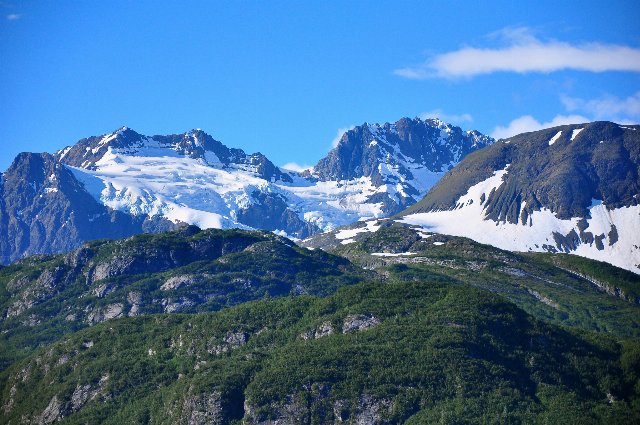Home » Regions » North America » Marine West Coast Forest » Pacific Coastal Mountains
Pacific Coastal Mountains
Last updated: June 10th, 2022
Page contents
↑About the Pacific Coastal Mountains
The Pacific Coastal Mountains are a mountainous region extending from just east of Anchorage, Alaska, southeast to a bit south of Stewart, British Columbia. This region can be seen as transitional between the more moderate ocean-influenced regions along the coast, and the more continentally-influenced regions farther inland. This is also the coldest region considered to be part of the Marine West Coast Forest.This region consists of steep, rugged mountains; summits tend to range from 2,100-4,500m (~6,900-14,750ft), and local relief between summits and valley bottoms is as high as 2,900m (9,500ft) in places. Features here largely formed through glaciation, and include aretes, horns, cirques, and U-shaped valleys. There are large ice fields and glaciers at the higher elevations. In Alaska there are a few places where the glaciers reach the sea, but most end above 150m (490ft).
The climate here is transitional between subarctic and a marine west coast climate, with high precipitation relative to the low temperatures. Precipitation is seasonal; especially at low to mid elevations, it tends to peak in October and be higher in winter, and driest in late spring through early summer. Summers are cool and winters cold, although low elevations are protected from some of the most severe winter cold. Cloud cover and precipitation tends to be highest, and temperatures most moderate, closest to the coast.
Much of this region is covered by glaciers and ice fields and completely devoid of vegetation. Plant growth here is relegated to the lower elevations around the margins of the region. Cover varies mostly by elevation. The warmest, lowest elevations feature closed-canopy forest of western hemlock (Tsuga heterophylla) and Sitka spruce (Picea sitchensis). at mid elevations there are more open subalpine forests of subalpine fir (Abies lasiocarpa) and mountain hemlock (Tsuga mertensiana), and some Sitka spruce. Above the tree line there is alpine tundra with heather, dwarf birch, willow, grasses, and lichens. Moving north through this region, vegetation becomes increasingly restricted to lower elevations. The heavy moderating effect of the ocean allows forests to reach to a higher elevation here relative to in more interior regions.
This region is sparsely populated, even more so than neighboring coastal areas. The largest settlements are located in Haines Borough, AK, and include Haines, Mosquito Lake, Mud Bay, Skagway, and the administratively-separate Klukwan; these areas total just over 2,000 people. In the south, the only settlement of any size is Stewart, BC with a population under 500, and adjacent Hyder, AK, which adds a few more people. In the north of this region there are some larger settlements at the border of this region, including Valdez and some settlements at the eastern border of the Anchorage metro area.
There is a large portion of public protected land here. Land use is not intensive, and is mostly either outdoor recreational activity, including mountaineering, and subsistence hunting and fishing. There is some mining and mineral exploration throughout the area. Overall, land use here is limited by the extreme climate and inaccessibility of most of this region.
This region is bordered coastally by the Coastal Western Hemlock-Sitka Spruce Forests, a more moderate, ocean-moderate region that is narrow in most places. In some of the steepest parts of the north, this region borders the water directly. The border to the south is with the Pacific and Nass Ranges, a similar region that is mainly distinguished by being warmer. Both of these borders represent gradual transitions. At the very north of this region, it is bordered to the north by the Cook Inlet, a lower, flatter region with a very moderate climate relative to how far north it is.
Inland, to the east and northeast, this region borders many different portions of the drier, more continentally-influenced Northwestern Forested Mountains. In the south, it borders the Skeena-Omineca-Central Canadian Rocky Mountains. North of that, it borders the Yukon-Stikine Highlands/Boreal Mountains and Plateaus, and north of that, the Wrangell and St. Elias Mountains. Farther north there is a small border with the Copper Plateau, and at the northern end, another short border with the Alaska Range. These regions all tend to have more diversity in vegetation cover, reflecting more drought-limited vegetation.
 This photo from Glacier Bay National Park in Alaska shows the vegetation transition in the Pacific Coastal Mountains, from evergreen rainforest at lower elevations to open coniferous forest and alpine meadows at higher elevations, with barren rock, glaciers, and ice fields at the top. Photo © Kimberly Vardeman, CC BY 2.0, Source.
This photo from Glacier Bay National Park in Alaska shows the vegetation transition in the Pacific Coastal Mountains, from evergreen rainforest at lower elevations to open coniferous forest and alpine meadows at higher elevations, with barren rock, glaciers, and ice fields at the top. Photo © Kimberly Vardeman, CC BY 2.0, Source.

